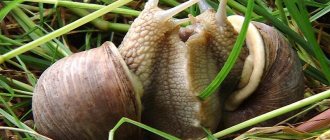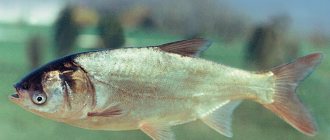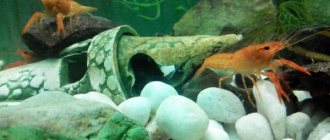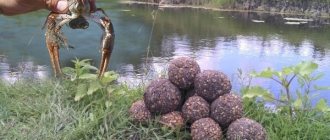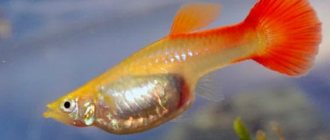Quickly navigate to the article
- 1. General Provisions
- 2 Aquariums with and without fish
- 3 Aquatic plants
- 4 Algae
- 5 Vegetables and fruits
- 6 Calcium
- 7 Fish food
- 8 How to feed snails in an aquarium
- 9 Nutrition of young individuals 9.1 Other interesting articles
Many aquarium owners keep snails without knowing at all whether they are compatible with other inhabitants of the aquarium and what these gastropods eat. As a result, it turns out that the snails have filled the entire aquarium, or only their shells remain, or the mollusks have destroyed all your well-groomed vegetation. To prevent this from happening, you need to carefully select all the living creatures, studying the characteristics of each species, and also feed all the inhabitants of your aquarium well so that no one wants to eat anyone or anything else. After this, the question arises of what to feed the snails in the aquarium. We will try to give a detailed answer to this in this article.
General provisions
Snails in an aquarium can be both its irreplaceable inhabitants and a scourge. If you approach the issue of populating and maintaining the aquarium correctly, then these mollusks will become not only decoration, but also to some extent cleaners, since some species, for example, neretina, clean the aquarium, decorations and plants from algae. In addition, mollusks eat detritus, dead decaying plants, dead fish and waste from other inhabitants. Snails are also an excellent option for breeding aquariums. Because cleaner fish are not against eating fish eggs, but snails are not interested in them as food.
There are several species of predatory snails, such as Helena, that feed on their plant-eating counterparts. With the help of such mollusks, the number of coils and melania can be controlled.
In their natural habitat, aquarium snails consume mainly plant food, which should be kept in mind when purchasing such pets. You should also take into account that you should not keep delicate and expensive plants in an aquarium with snails, since the mollusks can climb on them, and the leaves, unable to withstand such weight, will break. And if there is a lack of food, some species can dig up the bottom soil in search of food and dig up some small plants along with their roots. Therefore, it is worth planting inexpensive plants with hard and large leaves that can support the weight of mollusks.
When asked what to feed aquarium snails, the answer is that their diet should be vegetarian. Algae, various vegetables, fruits and herbs contain minerals, trace elements and vitamins necessary for a strong and beautiful shell, good digestion and proper development of these aquatic pets.
Tips for an aquarist
The microclimate and cleanliness in the aquarium directly depend on the snails, but when starting them, you should adhere to some rules:
- You should only purchase new residents of your home aquatic world at a pet store, and not catch them yourself in a pond . Such snails can harm fish;
- Monitor the saturation of the aquarium with plants. Everything should be in moderation! If there is a small amount, the snails will be hungry, and if they are oversaturated, they will not be able to cope with the “cleaning”;
- Check newly acquired plants for eggs and newborn snails. “Accidentally” bringing a guest into the aquarium will entail consequences - a fight for the population, destruction of fish eggs;
- Snails, especially small ones, are very often “offended” by fish - they bite off their antennae, are driven out of secluded places, damage their shells, and especially proactive ones can kill them. An even greater danger is posed by crayfish and shrimp, which remove mollusks from the shell and empty the shell. After settlement, control and monitoring of good neighborliness is extremely necessary;
- To feed the snails, the food must fall to the bottom. If vegetables float, they need to be weighed down.
Keeping and caring for snails does not bring much trouble to the owner, but their benefits are obvious: clean water and the walls of the vessel. With snails, the water world will become as close to nature as possible - beautiful and alive.
Aquariums with and without fish
In aquariums with various inhabitants, snails help clean the environment from waste products, and also eat up the remains of uneaten food and feel quite happy. Therefore, most aquarists do not have a question about what to feed snails in an aquarium with fish and other living creatures.
The question most often arises is what to feed snails in an aquarium without fish. In this case, you will have to feed the gastropods additionally. These animals can eat:
- aquatic plants,
- algae,
- fruits,
- vegetables and fish food.
Seaweed
The main food source for snails is algae. Algae grow well in an aquarium even without fish. The more light that hits the aquarium and the higher the temperature of the water in it, the faster and more algae will multiply on the walls, decorations and plants. Most snails clean algae from healthy plants, but leave the plants themselves alone.
Vegetables and fruits
Snails love to chew on various vegetables. The best way to feed aquarium snails at home is:
- carrots,
- cabbage,
- cucumber,
- zucchini,
- pumpkin,
- peas,
- salad and other greens.
Vegetables are thoroughly washed, peeled and cut. It is recommended to first scald tough vegetables, such as carrots and cabbage, with boiling water and cool them, and then feed them to shellfish.
The aquarium snail will not refuse many fruits. Put grapes, apples and pears in the aquarium; pets eat them well.
Avoid feeding acidic fruits and vegetables such as oranges, lemons, tomatoes, etc. Always wash and dry fruits, vegetables and herbs thoroughly, as chemicals from pesticides and water are harmful to the delicate creatures. The best option would be to leave your pet's food in purified water overnight. Be sure to peel vegetables and fruits that may contain harmful chemicals; in addition, it will be easier for snails to eat food in this form.
Vegetables and fruits can be secured using special clamps designed for use in aquariums. Thanks to the use of such fastening, it is easier for these slow-moving creatures to consume the offered food.
If you are just going to start introducing additional fertilizers for aquatic snails, then start with blanched vegetables. To do this, immerse the vegetables in boiling water for 2 minutes and then cool with cold water. Wait until the vegetables have cooled completely before immersing them in the aquarium. You can chop or chop the vegetables into small pieces.
Start adding small amounts of blanched vegetables every morning and see how quickly the snails can eat them. Add more or reduce the amount until you see everything is eaten within 12 hours or less. All residues must be removed no later than after 24 hours.
Calcium
As a rule, aquarium snails absorb calcium from the water. But if the water is not hard enough, then a shortage of this essential element occurs in the mollusk’s body and the shell of the mollusk begins to collapse. To prevent this from happening, it is necessary to provide an additional source of calcium, which will help keep the snail shells strong and healthy. Sources of calcium for aquatic snails include:
- Sepia or cuttlefish shell;
- Dead shellfish shells;
- Oyster shells;
- Natural limestone.
They can be placed in the aquarium whole so that the snails can gnaw on them if necessary, or they can be ground into powder and mixed in water.
Please note that adding calcium to water can lead to an increase in water hardness, which in turn can negatively affect other inhabitants of the aquarium.
How to feed snails in an aquarium
If only snails live in your aquarium, then you will not have to feed them more than if they lived with fish. Provide as much food as they can eat without the leftovers spoiling or contaminating the water. Try offering a small amount of food and evaluate how quickly your gastropods feast on the offered delicacies.
It will take some time for the snails to try the food offered, especially if there are a lot of plants and algae in the aquarium. If there are several individuals in the aquarium, then place the food in different places so that all pets can find it.
For pets to feel good, they must have adequate nutrition. If the snail does not have enough food, it will remain hungry, and systematic starvation will lead to exhaustion and death. And with too much food, the quality of the water will quickly deteriorate.
Most snails graze on aquarium plants, cleaning them of algae. They also eat algae from the walls of their homes and decorations, thereby improving their habitat. Mollusks will not refuse purchased food, for example, algae waffles.
Some aquarium owners feed their pets bloodworms, daphnia and meat. The meat is first chopped very finely or minced.
Inexperienced aquarists feed their pets with bread crumbs, which is not recommended. Since such food is very large and in most cases the snail cannot grab it. In addition, bread is a very rough food for this animal.
Depending on the size and type of snail you choose, you may need additional space and alternative food sources required by that species. Some species require food sources such as fish food or tablets. There are many different aquatic snails, so each aquarium owner can choose the most suitable options that will meet your needs.
Depending on the type of snail, the frequency of feeding will depend - every day or only a couple of times a week.
As a general rule, if you provide extra food for your snails and they don't eat it for several hours, you may be feeding them too often or offering too large portions. It may also mean that the clams don't understand that this is a food source, so try different options to see how they react to the foods offered.
Prohibited Products
It is strictly not recommended to consume certain types of food for domestic snails. This includes:
- products with a bitter or pungent taste: onions, garlic, chili peppers;
- vegetable products with a high content of natural acids: sorrel, citrus fruits, pineapple, cranberries;
- human food: sugar, salt, pasta, sweets;
- fatty dairy products (cheeses);
- fatty meat: pork, beef, lamb.
If you are unsure whether a particular type of food is suitable for home feeding your snails, do not feed it to avoid harming the animal's health.
Nutrition of young individuals
What to feed small snails? Small and hatched snails should be fed with fine fish food, as well as scalded lettuce and cucumber. The container with small gastropods must have good lighting so that algae grows in this container, a necessary component of the diet of young snails.
Almost all types of aquatic snails get along well in a community aquarium with other inhabitants. And only some of them need special conditions that will not suit other aquatic life. Snails can only become a problem if there is something wrong in the aquarium, and, more often than not, this is not a problem, but a signal for you to notice and eliminate the cause.
Now you know what to feed snails in an aquarium. The nutrition of aquatic snails must be sufficient, regardless of the presence of other inhabitants in the aquatic environment. It is necessary to monitor all the inhabitants of the aquarium to understand whether they have enough food, and provide them with additional feeding if necessary.
Other interesting articles
- What to feed crucian carp at home in an aquarium Crucian carp, perch, roach and ruffe are fish designed to exist in natural bodies of water. However, with…
- How long do turtles live at home in an aquarium? When getting any pet - a parrot, fish, rabbit, cat or turtle, there is a natural desire to find out...
- How long do catfish live in an aquarium at home? The aquarium catfish is not just an unusual fish whose behavior is very interesting to observe, but also...
Species of pond snails
The snail is considered a unique animal. This is due to the fact that they do not cause harm to humans, but they only benefit the aquarium. If you monitor the population of mollusks in the underwater world, they clean the aquarium of algae and plaque. There are several species of pond snails in nature. They differ in appearance and behavior. Can be kept individually or in groups.
Prudovka ordinary - large
The large pond fish, or as it is also called, the common pond fish, is the largest representative of the family. Such individuals are distinguished by an elongated shell that has a conical shape.
The snail is considered a unique animal
Dimensions:
- length – 4.5-6.5 cm;
- width – 2-3.5 cm.
The shell of the mollusk is twisted and resembles a spiral. There are 4-5 revolutions in total. The coils expand quite quickly. As a result, a large hole is formed.
This species is widespread
Snails are found in one shade - brown. The walls of the shells are thin and translucent. The body itself is greenish-gray in color. This species is widespread. Can be found in the Northern Hemisphere. They live exclusively in freshwater open reservoirs.
Small prudovik
The small pond fish is distinguished by an elongated shell with a sharp end. A sexually mature individual reaches 2 cm in length and 0.7 cm in width.
There are several subspecies:
- Fiza. It grows up to 10 mm in length, there is no spiral on the carapace. Can live in aquariums and moist soils.
- Ancilida. Is the largest representative. The sink resembles a steering wheel in appearance. Rarely found.
- Horn-shaped coil. Small in size, completely harmless, has a transparent shell. When kept in an aquarium, soft food is required.
- Allexa. A mollusk of a rich red hue, up to 20 mm in size.
Marsh pond snails have a small shell mouth
In nature, they live in small bodies of water - rivers, ponds, puddles.
Swamp pond snail
Swamp mollusks are no less interesting. In this species, the shell resembles a cone with a sharp edge. The mollusks grow up to 3.2 cm in height, while the width reaches 1 cm. Marsh pond snails have a small shell mouth. There are individuals with a brown or black shell. At the same time, the body is greenish-gray. The habitat is small-sized reservoirs without strong currents. If you create a suitable living environment at home, they can grow and reproduce in an aquarium.
Prudovki ovoid
The difference between the ovoid pond snail is its fragile shell. The third curl makes up 1/3 of the entire mouth.
The difference between the ovoid pond snail is that it has a fragile shell.
Snail dimensions:
- width – 1.5 cm;
- height – 2.7 cm.
The shell is transparent. The shade is light pink. The purges received this name due to their ovoid-shaped mouth. The body is light olive or gray in color. Mollusks live at quite great depths. In nature, it can be found in lakes or rivers with a quiet flow.
Prudovki ear
The pond snail is similar in appearance to the human auricle. An adult specimen has a height of 3.7-4 cm and a diameter of up to 3 cm. The shade of the mollusk is greenish-green. In nature, they live in small open water bodies. They can be found on wet stones and plant leaves.
They can be found on wet stones and plant leaves
Other species have not found such a distribution. However, they exist in nature. There are individuals that are able to live in reservoirs at a depth of up to 300 m or in mountains at an altitude of up to 5.5 thousand m.


